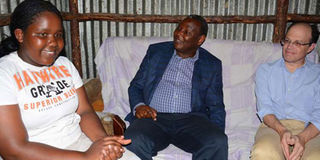‘Wings to Fly’ helping mould future leaders

Wings to Fly scholarship beneficiary Cynthia Kerubo (left) is visited in her Mukuru Kwa Njenga home by Equity Group Foundation Chairman Dr James Mwangi and Canadian High Commissioner David Angell during home verification visits by the Wings to Fly Community Scholarship Selection Board members. PHOTO | NATION MEDIA GROUP
What you need to know:
- Wings To Fly Programme, an initiative of Equity Bank, which has benefited over 10,000 students to date.
- Just like the airlift programme, the Wings To Fly Scholarship programme is revolutionising socio-economic development in Kenya by supporting 2,000 needy and bright students every year to access education, which is a basic right.
- The programme has currently surpassed its five-year goal, with over 10,000 students having benefited from the scholarship for which over 20,000 candidates apply yearly.
- The Wings To Fly Programme is a noble initiative that is giving bright but needy children access to quality education.
Over the last 13 years, Kenya has made remarkable progress in expanding access to education.
A recent report by United Nations Educational, Scientific and Cultural Organisation (Unesco) on Kenya’s status on Millennium Development Goals (MDGs) indicates that since the introduction of free primary education in 2003, enrolment for basic education rose significantly from 5.93 million children in 2000 to 10.2 million children in 2013.
Meanwhile, as the enrolment soars, so does the Kenyan population. According to the 2009 population census, the projected population for Kenya in 2013 was 41.8 million with an annual growth rate of about 2.97 per cent and a life expectancy of 63.3 years.
The population is fairly youthful with those aged 14 years and below forming about 43 per cent of the total population while those aged 25 years and below account for 62 per cent of the population.
The youthful population presents both opportunities and challenges to achieving the targets of the MDGs and other socio-economic objectives.
However, a majority of the population miss the opportunity to further their education as a result of poverty and being orphaned.
Looking at the recent Form One selection, more than 230,000 candidates who sat for the Kenya Certificate of Primary Education examination missed secondary school chances, according to the Ministry of Education. On the other hand, 927,789 candidates will be competing for about 700,000 available spaces in secondary schools countrywide.
CANNOT PAY FEES
A majority of the students qualify to go to school, but they will not be able to, since they cannot afford to pay for their secondary school education.
Although the government has channelled adequate bursary funds through the Constituency Development Fund (CDF) to support needy but bright students, many still miss the opportunity to secure a chance at a secondary school, university or tertiary institution
The private sector has also stepped in to support needy yet bright students to access education.
A case in point is the Wings To Fly Programme, an initiative of Equity Bank, which has benefited over 10,000 students to date.
This reminds me of the Airlift Africa Programme, an initiative of Minister Tom Mboya in the late 50s and 60s, that saw bright Kenyan students travel to America for further studies through the JF Kennedy Foundation.
President J F Kennedy — then a senator — chaired the senate subcommittee on Africa, and arranged a $100,000 grant through his family’s foundation to help Tom Mboya keep the programme running.
One of the first beneficiaries of the airlift was Barack Obama Snr, father of US President Barack Obama. Other beneficiaries included the late Wangari Maathai, winner of the 2004 Nobel Peace Prize.
Just like the airlift programme, the Wings To Fly Scholarship programme is revolutionising socio-economic development in Kenya by supporting 2,000 needy and bright students every year to access education, which is a basic right.
The initiative is also supported by The MasterCard Foundation among other partners like United States Agency for International (USAid); KfW — a German agency and individual donors as well as corporates.
TRANSPARENCY IN SELECTION
The programme has currently surpassed its five-year goal, with over 10,000 students having benefited from the scholarship for which over 20,000 candidates apply yearly.
One thing that makes Wings to Fly stand out is the transparency in the selection of the beneficiaries. This has been achieved by the participation of the Community Scholarship Selection Boards (CSSB) across the country.
The CSSB comprises at least 13 local representatives, who must be women and youth. Other stakeholders are chiefs, educators, civil society leaders, Equity Foundation agents and religious leaders.
The county education officer chairs the board and the secretary or coordinator is the local Equity Bank branch manager. The members serve on a voluntary basis.
Some of the students have gone ahead to win international scholarships for further studies in Ivy League universities like Harvard, Yale and MIT, among others.
The Wings To Fly Programme is a noble initiative that is giving bright but needy children access to quality education. The fruits of the programme will definitely enrich our country, the continent and make the world better.
The writer is the MP for Kibra




